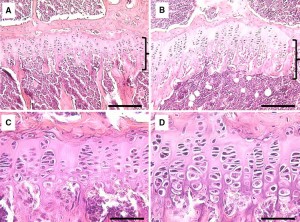This study shows that mechanical loading can alter the growth plate and the trabecular bone. This shows it is possible to use mechanical loading to alter height during development and also perhaps spinal height as there is a great deal of cartilage via the discs there.
Unveiling the Trabecular Connection: Exploring Morphological Adaptations in the Growth Plate and Their Response to Mechanical Stimulus
“The growth plate, also known as the epiphyseal plate, is a critical element in the longitudinal growth of long bones during development. This study aims to explore the connection between trabecular patterns and morphological alterations within the growth plate, particularly concerning their impact on shape and mamillary processes or trabecular patterns as well as the formation of ossification bridges{ossification bridges has the potential to reduce growth so studying them has potential}. Our objective is to investigate how the adaptations in the growth plate and the trabecular bone in its vicinity respond to mechanical stimulus, this approach is considered a new methodology to study endochondral growth and bone remodelling”
“Our investigation revealed insights into the development of the growth plate and its capacity to adapt its shape in response to the local mechanical environment. Previously, this environment had been predominantly modeled as a continuum, but our model allowed us to assess the impact of localized load transmission via the trabecular groups. Furthermore, our research demonstrated that the morphological changes within the growth plate in addition to bone adaptation in its vicinity, serve as an adaptive mechanism to withstand shear stress{so we would want to optimally induce shear stress, I believe that torsional loading is the best way to induce fluid shear}, contributing to increased bone density in specific regions”
“at birth the growth plates have a flat and smooth topology in humans, as age increases a wavy pattern is seen, this change is due to mechanical stresses”
“The thickness in the growth plate remains constant during childhood thanks to an equilibrium between chondrocyte proliferation and apoptosis. In puberty, when this balance is perturbed, the process of growth plate fusion starts, forming ossification bridges in different locations until the entire plate has been ossified, leaving behind a bone remnant, formally known as epiphyseal scar”
“animals, such as mice and rats, which are widely used as in-vivo models for endochondral ossification studies, do not entirely close their growth plates during maturation”<-but their growth plates do seem to be become senescent which indicates that there may be epigenetic factors that limit growth plates from growing indefinitely.


“the change in shape in the growth may occur as a consequence of the bone remodeling process in the vicinity of the growth plate, and at the same time trabecular formations adapt”

change in geometrical descriptors; simply by including a transphyseal screw in the domain.”<-so there is potential for this research to be used for people to grow taller.
